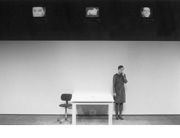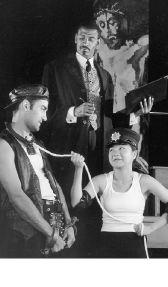AFTER A LONG hibernation, New City Theater reawakens with Snow, a piece that, for better or worse, stands on the shoulders of the 21st century. John Jesurun, a visionary performance artist and MacArthur Fellow, creates a theatrical work that is best described as a 75-minute, high-tech art installation. And while it covers some familiar terrain, it ultimately has brains enough to pick yours.
Snow
New City Theater ends December 16
The show depends upon a techie’s wet dream of big-screen gadgetry: four computers, 20 “smart” cameras, surround sound, and four projectors. However, the multimedia assemblage does more than drizzle a plot with digitized spectacle; the story delves into a world controlled by a television network that produces mediocre shows with extremely high ratings. Relying on programs to control popularity ratings, any writer or actor of exceptional talent or deviation from the norm is instantly fired. This plot, which borders on whining, should be thematically transparent to theater and indie-film buffs—we’ve seen it many times before.
Jesurun diverts from the norm through a manipulation of both the audience and the actors within their separate spaces. After entering, the audience is cloistered in a small room, with walls painted the soothing blue of 2am television and four large screens secured to the false ceiling. The action takes place outside the room and is projected overhead; the audience is forced to crane their necks and watch dizzily. Talking Heads’ David Byrne once said that “looking up is as terrifying as the vertigo of looking down,” and when watching these characters in the privacy of their dressing rooms and offices, talking on projections with faces as large as Big Brother, I knew what Byrne meant. The actress and producers tape their “scenes” and daily life with the knowledge that they are being recorded, yet they are not in control of the film. Reality and performance intertwine as the network becomes more and more reliant on the machinations of the computers that manipulate them and subsequently grows distrustful of everything else.
PARALLELING THE characters’ creative corruption by technology, Jesurun abdicates direction and live action for voice-activated cameras. Thus, the advent of techno-media widens the gulf between artistry and communication within the play’s delivery. Live recordings don’t fill the gap with spontaneous magic; instead, they call into question whether technology is pulling the human actors’ strings.
This is thinking theater, mind you—the writing and dialogue are funny, fast, and dark enough to be ripped from the pages of a Joseph Heller novel. The network puts on nonsensical epics with tearful tsarinas, geishas waxing poetic, and parties that postproduction transforms into funerals.
As the producers, Mary Ewald and Peter Crook play power-toting paranoids to a humorous, though unsettling, degree, while Valerie Charles abandons herself to the creepy role of Cricket with unflattering panache that would make Baby Jane proud. What resonates about this whole theater experience is that the modern story is truly arbitrary, as is the medium responsible for conveying information. In this landscape, through Jesurun’s presentation of an ever-changing reality, the snow doesn’t fall from the sky but is generated from TV fuzz.






